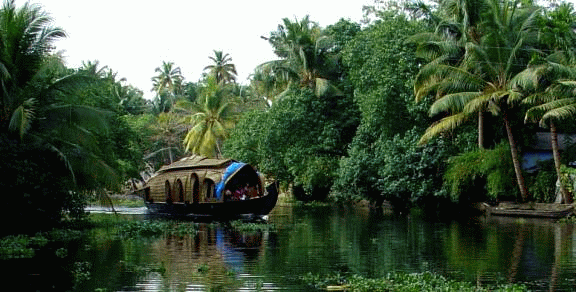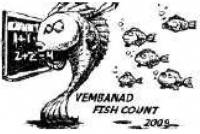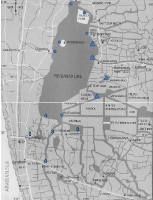 The Vembanad estuarine system, the largest of its kind on the west coast of India is known to be abundantly enriched with diverse fishery resources, providing feeding, spawning and rearing areas for a very large proportion of commercial (fin) fish and shellfish. However, ecosystem health of the Vembanad wetlands is alarmingly declining due to a variety of reasons - obstruction of river courses, sand mining & habitat destruction, loss of riparian canopy cover, encroachment, pollution and unethical fishing practices. Reduced summer flow due to drying up of rivers and pollution hazards from agro-chemicals and sewage also lead to mass mortality of fishes. Depletion of fishery resources has changed this ‘inland fish basket’ to an ‘inland wastebasket’, driving the fisherfolk, the primary stakeholders of the lake into a livelihood crisis.
The Vembanad estuarine system, the largest of its kind on the west coast of India is known to be abundantly enriched with diverse fishery resources, providing feeding, spawning and rearing areas for a very large proportion of commercial (fin) fish and shellfish. However, ecosystem health of the Vembanad wetlands is alarmingly declining due to a variety of reasons - obstruction of river courses, sand mining & habitat destruction, loss of riparian canopy cover, encroachment, pollution and unethical fishing practices. Reduced summer flow due to drying up of rivers and pollution hazards from agro-chemicals and sewage also lead to mass mortality of fishes. Depletion of fishery resources has changed this ‘inland fish basket’ to an ‘inland wastebasket’, driving the fisherfolk, the primary stakeholders of the lake into a livelihood crisis.
Traditionally, conservation and management of the lake resources of Vembanad were vested in the hands of the local communities and hence, local communities were actively involved and interested in the management of the resources they relied on. Ashoka Trust for Research in Ecology and the Environment (ATREE) is trying to work towards a deliberative, democratic conservation strategy for the conservation of the Vembanad wetland, so as to ensure the participation of the communities in conservation of the lake.
communities and hence, local communities were actively involved and interested in the management of the resources they relied on. Ashoka Trust for Research in Ecology and the Environment (ATREE) is trying to work towards a deliberative, democratic conservation strategy for the conservation of the Vembanad wetland, so as to ensure the participation of the communities in conservation of the lake.
 With the intention of regaining the participatory methods in lake management and to enhance cooperation between various stakeholders, Government departments, NGOs and academic institutions and to create awareness about the state of fishery resources of the lake, ATREE in collaboration with Regional Agricultural Research Station (RARS) Kumarakom, Kerala State Biodiversity Board, School of Environmental Sciences - Mahatma Gandhi University Kottayam, School of Applied Life Sciences Pathanamthitta, St Albert's College Ernakulam, College of Fisheries Panangad, Vembanad Nature Club Muhamma and various Kayal Samrakshana Samithys (Lake Protection Forums) around Vembanad, attempted to conduct a “Vembanad Fish Count" in 2008 and 2009, a participatory fishery resource inventory (census) and monitoring of the Lake, involving scientists, naturalists, students, fishermen, and interested people. Besides inventorisation, the effort was also aimed to create mass awareness among the general public on conservation of Vembanad Lake through more sensible management practices.
With the intention of regaining the participatory methods in lake management and to enhance cooperation between various stakeholders, Government departments, NGOs and academic institutions and to create awareness about the state of fishery resources of the lake, ATREE in collaboration with Regional Agricultural Research Station (RARS) Kumarakom, Kerala State Biodiversity Board, School of Environmental Sciences - Mahatma Gandhi University Kottayam, School of Applied Life Sciences Pathanamthitta, St Albert's College Ernakulam, College of Fisheries Panangad, Vembanad Nature Club Muhamma and various Kayal Samrakshana Samithys (Lake Protection Forums) around Vembanad, attempted to conduct a “Vembanad Fish Count" in 2008 and 2009, a participatory fishery resource inventory (census) and monitoring of the Lake, involving scientists, naturalists, students, fishermen, and interested people. Besides inventorisation, the effort was also aimed to create mass awareness among the general public on conservation of Vembanad Lake through more sensible management practices.
Fish Count - 2008
The first edition of the fish count was held on 30th May 2008. 51 species of finfish representing 26 families and 35 genera, as well as 10 species of shell fish belonging to 6 families and 7 genera were recorded during this fish count. Out of this, two species of fishes are listed as ‘Critically Endangered’, four ‘Endangered’ and five species are ‘Vulnerable’ according to IUCN Red data book. The sector around Pathiramanal Island was observed to be the richest sector (in terms of fishes) of the total area surveyed.
Fish Count - 2009
The second edition of the fish count was held on 26th and 27th May 2009, and involved a wider group of organisers and participants. 65 species of finfish and 14 species of shell fish were recorded. Again, the sector around Pathiramanal Island was observed to be the richest sector surveyed with about 50 fish species recorded.
In total, the survey recorded 13 more native fish species and 3 shell fish species to the fish fauna of the lake over the previous year's fish count. It also recorded two exotic species (Sucker catfish and Sutchi catfish) in the lake, for the first time. Amongst the newly recorded species, 8 were estuarine species which proliferated the lake due to the timely opening of the Thannermukkom salt water barrier and the remaining 5 were typical riverine species. Three species - Indian shortfin eel, Indian mottled eel and Walking catfish were found to have disappeared from the lake. This development has been caused by stake net operations and dams in the northern part of the lake, which obstruct the migratory pathway of eels. The 2009 fish count report also points to a new threat to the native fish species of Vembanad Lake - Invasive Alien Species such as the exotic Sucker catfish.
The attached reports contain a summary of the findings of the two fish count exercises and has details of the various species recorded and water quality results and lists various recommendations towards better conservation and management of the lake. It paves way for future course of action as ATREE plans to make this an annual event, involving more and more interested agencies and people. The fish count exercise is expected to become more accurate and relevant in the years to come with more and more active participation of people, who in turn will take the lead in conserving this great natural heritage of Vembanad lake.
More details about ATREE's work on Vembanad lake are here.
Read the reports:
/articles/vembanad-fish-count-report-participatory-fish-resources-surveys-vembanad-lake-kerala-done